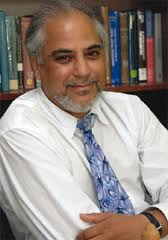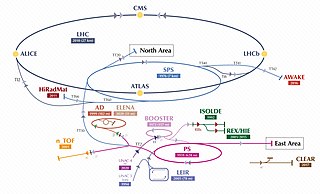Related Research Articles

The European Organization for Nuclear Research, known as CERN, is an intergovernmental organization that operates the largest particle physics laboratory in the world. Established in 1954, it is based in a northwestern suburb of Geneva, on the France–Switzerland border. It comprises 23 member states. Israel, admitted in 2013, is the only non-European full member. CERN is an official United Nations General Assembly observer.

A linear particle accelerator is a type of particle accelerator that accelerates charged subatomic particles or ions to a high speed by subjecting them to a series of oscillating electric potentials along a linear beamline. The principles for such machines were proposed by Gustav Ising in 1924, while the first machine that worked was constructed by Rolf Widerøe in 1928 at the RWTH Aachen University. Linacs have many applications: they generate X-rays and high energy electrons for medicinal purposes in radiation therapy, serve as particle injectors for higher-energy accelerators, and are used directly to achieve the highest kinetic energy for light particles for particle physics.
ISABELLE was a 200+200 GeV proton–proton colliding beam particle accelerator partially built by the United States government at Brookhaven National Laboratory in Upton, New York, before it was cancelled in July, 1983.
A collider is a type of particle accelerator that brings two opposing particle beams together such that the particles collide. Colliders may either be ring accelerators or linear accelerators.

Simon van der Meer was a Dutch particle accelerator physicist who shared the Nobel Prize in Physics in 1984 with Carlo Rubbia for contributions to the CERN project which led to the discovery of the W and Z particles, the two fundamental communicators of the weak interaction.

The Compact Linear Collider (CLIC) is a concept for a future linear particle accelerator that aims to explore the next energy frontier. CLIC would collide electrons with positrons and is currently the only mature option for a multi-TeV linear collider. The accelerator would be between 11 and 50 km long, more than ten times longer than the existing Stanford Linear Accelerator (SLAC) in California, USA. CLIC is proposed to be built at CERN, across the border between France and Switzerland near Geneva, with first beams starting by the time the Large Hadron Collider (LHC) has finished operations around 2035.

The Budker Institute of Nuclear Physics (BINP) is one of the major centres of advanced study of nuclear physics in Russia. It is located in the Siberian town Akademgorodok, on Academician Lavrentiev Avenue. The institute was founded by Gersh Budker in 1959. Following his death in 1977, the institute was renamed in honour of Academician Budker.
Plasma acceleration is a technique for accelerating charged particles, such as electrons, positrons, and ions, using the electric field associated with electron plasma wave or other high-gradient plasma structures. The plasma acceleration structures are created either using ultra-short laser pulses or energetic particle beams that are matched to the plasma parameters. These techniques offer a way to build high performance particle accelerators of much smaller size than conventional devices. The basic concepts of plasma acceleration and its possibilities were originally conceived by Toshiki Tajima and John M. Dawson of UCLA in 1979. The initial experimental designs for a "wakefield" accelerator were conceived at UCLA by Chandrashekhar J. Joshi et al. Current experimental devices show accelerating gradients several orders of magnitude better than current particle accelerators over very short distances, and about one order of magnitude better at the one meter scale.

The ISOLDE Radioactive Ion Beam Facility, is an on-line isotope separator facility located at the heart of the CERN accelerator complex on the Franco-Swiss border. The name of the facility is an acronym for Isotope Separator On Line DEvice. Created in 1964, the ISOLDE facility started delivering radioactive ion beams to users in 1967. Originally located at the SynchroCyclotron accelerator, the facility has been upgraded several times most notably in 1992 when the whole facility was moved to be connected to CERN's ProtonSynchroton Booster (PSB). Entering its 6th decade of existence, ISOLDE is currently the longest-running facility in operation at CERN, a longevity due to a continuous development of the facility and its experiments that has kept ISOLDE at the forefront of science with radioactive ion beams. From the first pioneering isotope separation on-line (ISOL) beams to the latest technical advances allowing for the production of the most exotic species, ISOLDE benefits a wide range of physics communities with applications covering nuclear, atomic, molecular and solid-state physics, but also biophysics and astrophysics, as well as high-precision experiments looking for physics beyond the Standard Model. The facility is operated by the ISOLDE Collaboration, comprising CERN and fifteen (mostly) European countries. As of 2019, more than 800 experimentalists around the world are coming to ISOLDE to perform typically 45 different experiments per year.

The AWAKE facility at CERN is a proof-of-principle experiment, which investigates wakefield plasma acceleration using a proton bunch as a driver, a world-wide first. It aims to accelerate a low-energy witness bunch of electrons from 15 to 20 MeV to several GeV over a short distance by creating a high acceleration gradient of several GV/m. Particle accelerators currently in use, like CERN's LHC, use standard or superconductive RF-cavities for acceleration, but they are limited to an acceleration gradient in the order of 100 MV/m.

The ISR was a particle accelerator at CERN. It was the world's first hadron collider, and ran from 1971 to 1984, with a maximum center of mass energy of 62 GeV. From its initial startup, the collider itself had the capability to produce particles like the J/ψ and the upsilon, as well as observable jet structure; however, the particle detector experiments were not configured to observe events with large momentum transverse to the beamline, leaving these discoveries to be made at other experiments in the mid-1970s. Nevertheless, the construction of the ISR involved many advances in accelerator physics, including the first use of stochastic cooling, and it held the record for luminosity at a hadron collider until surpassed by the Tevatron in 2004.
Stochastic cooling is a form of particle beam cooling. It is used in some particle accelerators and storage rings to control the emittance of the particle beams in the machine. This process uses the electrical signals that the individual charged particles generate in a feedback loop to reduce the tendency of individual particles to move away from the other particles in the beam.

Swapan Chattopadhyay CorrFRSE is an Indian American physicist. Chattopadhyay completed his PhD from the University of California (Berkeley) in 1982.

The Antiproton Decelerator (AD) is a storage ring at the CERN laboratory near Geneva. It was built from the Antiproton Collector (AC) to be a successor to the Low Energy Antiproton Ring (LEAR) and started operation in the year 2000. Antiprotons are created by impinging a proton beam from the Proton Synchrotron on a metal target. The AD decelerates the resultant antiprotons to an energy of 5.3 MeV, which are then ejected to one of several connected experiments.

A particle accelerator is a machine that uses electromagnetic fields to propel charged particles to very high speeds and energies, and to contain them in well-defined beams.
An energy recovery linac (ERL) provides a beam of electrons used to produce x-rays by synchrotron radiation. First proposed in 1965 the idea gained interest since the early 2000s.

The Antiproton Accumulator (AA) was an infrastructure connected to the Proton–Antiproton Collider – a modification of the Super Proton Synchrotron (SPS) – at CERN. The AA was built in 1979 and 1980, for the production and accumulation of antiprotons. In the SppS the antiprotons were made to collide with protons, achieving collisions at a center of mass energy of app. 540 GeV. Several experiments recorded data from the collisions, most notably the UA1 and UA2 experiment, where the W and Z bosons were discovered in 1983.
Chandrashekhar "Chan" Janardan Joshi is an Indian-American experimental plasma physicist. He is known for his pioneering work in plasma-based particle acceleration techniques for which he won the 2006 James Clerk Maxwell Prize for Plasma Physics.

The Super Proton–Antiproton Synchrotron was a particle accelerator that operated at CERN from 1981 to 1991. To operate as a proton-antiproton collider the Super Proton Synchrotron (SPS) underwent substantial modifications, altering it from a one beam synchrotron to a two-beam collider. The main experiments at the accelerator were UA1 and UA2, where the W and Z bosons were discovered in 1983. Carlo Rubbia and Simon van der Meer received the 1984 Nobel Prize in Physics for their contributions to the SppS-project, which led to the discovery of the W and Z bosons. Other experiments conducted at the SppS were UA4, UA5 and UA8.
An electron–ion collider (EIC) is a type of particle accelerator collider designed to collide spin-polarized beams of electrons and ions, in order to study the properties of nuclear matter in detail via deep inelastic scattering. In 2012, a whitepaper was published, proposing the developing and building of an EIC accelerator, and in 2015, the Department of Energy Nuclear Science Advisory Committee (NSAC) named the construction of an electron–ion collider one of the top priorities for the near future in nuclear physics in the United States.
References
- ↑ Proceedings of Cern Accelerator School Workshop on Beam Cooling and related topics, Montreux October 1993
- ↑ van der Meer, S. (1985). "Stochastic cooling and the accumulation of antiprotons" (PDF). Reviews of Modern Physics. 57 (3): 689–697. Bibcode:1985RvMP...57..689V. doi:10.1103/RevModPhys.57.689.
- ↑ I. Meshkov, Electron Cooling: Status and Perspectives, Physics of Particles and Nuclei, Vol. 25, Issue 6, pp. 631-661, 1994
- ↑ Parkhomchuk, V V; Skrinsky, A N (1 July 1991). "Electron cooling: physics and prospective applications". Reports on Progress in Physics. 54 (7): 919–947. Bibcode:1991RPPh...54..919P. doi:10.1088/0034-4885/54/7/001. S2CID 250856492.
- ↑ E. Bonderup, Laser Cooling, CAS 1993, CERN 95-06, pp. 731-748